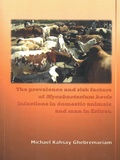The prevalence and risk factors of Mycobacterium bovis infections in domestic animals and man in Eritrea

Ghebremariam, Michael
- Promoter:
- Prof.dr. M. (Mirjam) Nielen & prof.dr. V.P.M.G. (Victor) Rutten
- Co-promoter:
- Prof.dr. A.L. (Anita) Michel, Pretoria
- Research group:
- Rutten
- Date:
- September 25, 2018
- Time:
- 10:30 h
Summary
The aim of this thesis was to explore the prevalence of Mycobacterium bovis (M. bovis) infection (bovine tuberculosis; BTB) and its potential risk factors for animals and humans in Eritrea. To that end, BTB prevalence in the intensive livestock production system (dairy cattle) in three major milk producing regions (Maekel, Debub & Anseba), and in the extensive livestock (mixed crop-livestock, and pastoral) system in cattle, goats, and camels in four regions (Debub, Anseba, Gash Barka, and Southern Red Sea) of Eritrea was investigated. The investigation in the intensive system was conducted by subjecting more than halve of Eritrea’s dairy cattle population (around 15,000), to the single intradermal comparative tuberculin test (SICTT). Skin test results were interpreted according to guidelines of the World Organization for Animal Health (OIE) with > 4 mm as cut-off in skin thickness increase. In addition, we studied the relationship between ‘physiological’ variables related to pregnancy and lactation, and the variable ‘region’ on the probability to be skin test positive. The individual animal and herd BTB prevalence in the dairy sector were variable across the country with Maekel having the highest (21.5% & 40.9%), followed by Debub, 7.3% and 10%, and Anseba, 0.2% and 1.6%, respectively. The overall individual animal and herd prevalence within the dairy sector was 11% and 17.3%, respectively, and pregnant-lactating cattle were more at risk for being SICTT positive, as compared to the other categories. This study was followed by an investigation that attempted to associate the potential herd-level risk factors with the herd prevalence reported, by including case and control herds with and without reactor animal(s), respectively. A questionnaire provided relevant variables (risk factors). The result of this study showed that herds with higher numbers of cows, and those at farms with concrete floors, were more at risk for being SICTT positive, compared with their references in the dairy sector.
The BTB prevalence study in the extensive livestock production system examined cattle (n = 1077), goats (n = 876), and camels (n = 195) using SICTT, and studied its potential risk factors in animals (migration, multispecies mixing at water points and pasture, introduction of new animals into existing herds) and in humans (lack of awareness of the consequences of drinking raw contaminated milk, close contact with their animals, sharing of the same dwelling with their animals), using questionnaire. The skin test results were interpreted using the standard (> 4 mm cut-off) and severe (> 2 mm cut-off) methods. The overall prevalence of BTB in the livestock within this system was low, but was spread throughout most of the sampled regions. In addition, consumption of unpasteurized milk was common.
To determine if M. bovis was circulating in the dairy cattle in Eritrea, and to gain insight into its spatial and temporal distribution, a molecular study was conducted on tissues with tuberculosis-like lesions (TBL) collected at the Asmara municipal slaughterhouse, the largest in Eritrea. The results revealed the most important strains of M. bovis in Eritrea and their (dis)similarities with the strains generally present in East Africa and Europe, as well as potential routes of introduction of M. bovis in the country.
To gain insight into the role of M. bovis in human tuberculosis in the country, sputum samples from multidrug resistant tuberculosis (MDR-TB) suspected patients were investigated using molecular detection techniques. This study was not able to identify M. bovis in the collected samples, but it did identify M. tuberculosis strains and four NTM species [M. sherrisii, M. yongonense, M. intracellulare, and M. avium].
In conclusion, the studies in this thesis highlighted high BTB prevalence in the intensive (dairy sector), and conversely, low prevalence in the extensive livestock systems in Eritrea. In addition, the studies have highlighted the presence of NTM in human patients in Eritrea and identified several risk factors for M. bovis infection in animals and humans.
The lesson learned are: strict livestock movement control must be in place and extra caution must be taken when moving animals from high BTB prevalence areas to the low prevalence areas; purchase of animals, especially for dairy purposes, should be tested for BTB; rigorous awareness raising campaign must be executed in regard to the danger of keeping of infected animals in the herds, and drinking of unpasteurized contaminated milk; the presence of NTM must be suspected in human patients with MDR-TB and the presence of M. bovis should be further investigated including the use of pyruvate enriched L-J medium to enhance the chance of M. bovis detection in humans.
The information obtained from this thesis will be instrumental in making informed decisions in the design of future BTB control and eradication strategies for Eritrea.